
Baseball in World War II
The Persian Gulf War was mercifully short, but during its six-week duration sports administrators drew up contingency plans for shorter seasons, reduced rosters and other expedients that would allow them to carry on in a time of conflict. There had been a precedent for their thinking. In the four years following the Japanese attack on Pearl Harbor on Dec. 7, 1941, the U.S. sports community was forced to adjust to wartime conditions.
The 1942 Rose Bowl, held just 25 days after the "day that will live in infamy," was played in Durham, N.C., a town thought to be safer from Japanese bombing raids than Pasadena. Because of the shortage of players in 1943, the Pittsburgh Steelers and the Philadelphia Eagles merged to form the Steagles, a team that went 5-4-1 over one season of existence.
On July 8, 1942, automobile and motorcycle racing were suspended entirely for the duration of the war. Thoroughbred racing was banned on Jan. 2, 1945, but reinstated only four months later, after V-E day. As a result, Hoop Jr. won the Kentucky Derby on June 9 of that year. Only one other time has the race been run on a date other than one in May. His Eminence won it on April 29, 1901.
For a time, it looked as if there would be no baseball at all for the duration, but according to lore, Washington Senators owner Clark Griffith persuaded President Franklin Roosevelt to encourage its continuance. In a Jan. 14, 1942, letter, baseball commissioner Judge Kenesaw Mountain Landis requested formal guidance from the commander-in-chief. "Baseball is about to adopt schedules, sign players, make vast commitments, go to training camps," wrote Landis. "What do you want it to do?" Landis listed several options, ranging from shutting down entirely to conducting business as usual.
"I honestly feel that it would be best for the country to keep baseball going," Roosevelt replied on Jan. 16 in what came to be known as the Green Light letter. In the President's opinion, the 5,000 to 6,000 athletes who played in organized baseball would provide a welcome diversion for the 20 million hard-pressed citizens directly involved with the war effort. The President ended the letter with this thought: "...and that, in my judgment, is thoroughly worthwhile." Thus was baseball preserved, though not exactly intact.
During most of the war effort, the Selective Service could call to arms any able-bodied man between the ages of 18 and 38. Ballplayers were given their draft numbers like everyone else and waited their turn to be called. And like everyone else, ballplayers were entitled to deferments. Ted Williams, who supported his mother, and Joe DiMaggio, who had a wife and young son, were classified in less draft-prone categories for the 1942 season—and both were criticized for it. Stan Musial, who supported his parents and had a wife and child, waited undeferred for his draft notice, which did not arrive until 1944. Cleveland pitcher Bob Feller joined the Navy in December 1941 of his own accord. Detroit's Hank Greenberg, who had fulfilled his military obligation, reenlisted in 1941, immediately after Pearl Harbor.
On some draft boards there was a backlash against professional athletes, and anyone with PA (professional athlete) stamped on his induction papers was put in uniform whether he was physically qualified or not As a result, Red Ruffing, the 38-year-old pitcher for the Yankees, who was missing four toes on his left foot, was accepted into the service. This might have been even more unfair had Ruffing not spent his 2½-year hitch playing service ball. Truth be told, the duty to hit-and-run for your country became the assignment for most major leaguers who were called up.
The outcry against supposedly fit players hitting baseballs instead of the trenches goaded Senator William Langer of North Dakota to call for legislation in the spring of 1945 that would have required each major league club to have 10% of its roster made up of athletes who were missing a hand, an arm or a leg. The end of the war also ended such talk.
Still, baseball contributed its fair share of manpower to the war effort. According to The Sports Encyclopedia: Baseball, the 16 major league teams sent 428 men to the armed forces. The first to go, on March 8, 1941, was pitcher Hugh Mulcahy of the Phillies, who joined the Army. The inevitable dilution of talent eventually required team owners to make do with the oddest, and perhaps the most inept, contingent of players ever seen on major league playing fields.
On the field, matters often went from predictably bad to worse to ludicrous. In 1944, Brooklyn Dodger manager Leo Durocher, 38, furious at the incompetence of his infield, reactivated himself as a second baseman for a preseason exhibition game and promptly broke his thumb in two places, the result of a bad throw from shortstop Gene Mauch. Jimmie Foxx, the Athletics and Red Sox slugger who had retired after the 1942 season, was coaxed back onto the field by the Cubs in 1944, and again by the Phillies in the following season. Foxx, 36, appeared in 89 games for Philadelphia and hit .268. But he also pitched on nine occasions, starting two games, and ended the season with a record of 1-0 and an eye-opening ERA of 1.57.
Other graybeards back in uniform included Babe Herman, who had ended his pro career in 1937. Herman, 42, played for Brooklyn in 1945 and, recalling his earlier days with the Dodgers' Daffiness Boys of the '30s, singled in his first at bat and fell down rounding first. Ben Chapman, who was an outfielder with the Yankees in the '30s, was reincarnated as a pitcher for Brooklyn in 1944 and went 5-3. The following season, he had a 3-3 record, pitching for both the Dodgers and the Phillies.
At the other end of the age scale, Nelson Fox was still in the Boy Scouts when, at 16, he went to spring training with the 1944 Philadelphia Athletics. And 15-year-old Joe Nuxhall took the mound for Cincinnati on June 10, 1944, giving up five runs on two hits and five walks in just two thirds of an inning.
The names, numbers and misadventures of the 1942-45 seasons read like a Who's Not Who of baseball:
Nick Etten of the Yankees won the 1944 home run title with 22 dingers, the fewest since Babe Ruth tied Tilly Walker for the 1918 title, with 11.
The 1944 World Series was played between the Browns and their Sportsman's Park cotenants, the St. Louis Cardinals. A play that might have typified the times came on Cardinal pitcher Max Lanier's sacrifice bunt in the third inning of the second game. Only two errors were officially charged, but the way Browns manager Luke Sewell saw it, "We made six misplays on the ball. That's pretty difficult." The Browns lost that game 3-2 in the 11th inning, and they eventually lost the Series in six games. Even that was something of an upset according to Chicago American sportswriter Warren Brown, who before the Series began had written that "neither team was capable of winning."
Any discussion of errors would be in complete without mentioning Cubs shortstop Len Merullo, who made four in one inning on Sept. 13, 1942. His son, Leonard Jr., was born on that day, and both father and son were henceforth nicknamed Boots.
It wasn't just baseball's personnel that was affected by the war. Even the way the game was played had bizarre moments. One of the strangest occurred at an exhibition contest to sell war bonds that took place at New York's Polo Grounds on June 26, 1944. On that day, the home-standing Giants not only played the hometown-rival Dodgers, but they also played the hometown Yankees. The Dodgers played the Yankees, too. In the same game.
Using a format concocted by Paul A. Smith, a Columbia University mathematics professor, the Giants, Dodgers and Yankees played a three-cornered, nine-inning game won by the Dodgers by a score of 5-1 (Yankees) to 0 (Giants). The Yankees batted in the top of the first, sixth and seventh innings, and in the bottom of the third, fourth and ninth. The other two teams also batted and fielded six times, three times each against their two rivals. Mayor Fiorello LaGuardia threw out three first balls in front of 50,000 fans, all of whom had gained admission by buying one or more war bonds. The bond drive was estimated to have raised $6 million.
It has become fashionable to believe that wartime baseball was not truly awful. It was. And yet, let's not be too disparaging. After all, the Browns' 1944 pennant-winning percentage of .578 would have won two of the four major league division titles in 1990 and three of four in 1989.
PHOTO
NATIONAL BASEBALL LIBRARY, COOPERSTOWN, N.Y.
The only American League title in the St. Louis Browns' 52-year history was won in 1941.
PHOTO
AP
Detroit home run hitter Hank Greenberg (center) signed up for a different uniform in 1941.
PHOTO
ARTHUR S. SIEGEL
Back in the game in 1945, Feller and Greenberg got reacquainted with the horsehide.
William Jeanes is the editor in chief of "Car and Driver" magazine.

